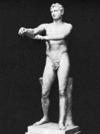- Lysippus
-
/luy sip"euhs/, n.fl. c360-c320 B.C., Greek sculptor.
* * *
or LysipposGreek sculptor.He was famous for the new and slender proportions of his figures and for their lifelike naturalism. He reportedly made more than 1,500 works, most in bronze. None survive, but some copies may be reliably ascribed to him, including Apoxyomenos, a young athlete scraping oil from his skin. Another key work is the colossal Heracles at Sicyon. He made many portrait busts of Alexander the Great from boyhood on; it was said that Alexander would have no other sculptor portray him. Apoxyomenos, Roman marble copy of Greek bronze by Lysippus, с ...AndersonAlinari from Art Resource
Apoxyomenos, Roman marble copy of Greek bronze by Lysippus, с ...AndersonAlinari from Art Resource* * *
▪ Greek sculptorflourished c. 370–c. 300 BC, Sicyon, GreeceGreek sculptor, head of the school at Argos and Sicyon in the time of Philip of Macedon (Philip II) and especially active during the reign of Philip's son Alexander the Great (336–323 BC). Lysippus was famous for the new and slender proportions of his figures and for their lifelike naturalism.Originally a worker in metal, he taught himself the art of sculpture by studying nature and the Doryphorus (“Spearbearer”) of Polyclitus, whose canon of ideal male proportions he modified by creating a smaller head and slimmer body that increased his figures' apparent height.Lysippus is said by the Roman writer Pliny the Elder (1st century AD) to have made more than 1,500 works, all of them in bronze. Of these, not one has been preserved, nor is there a completely reliable copy. There are, however, a few copies that may be ascribed to him with some certainty. The best and most reliable is that of the Apoxyomenos, a young male athlete, scraping and cleaning his oil-covered skin with a strigil. The original Apoxyomenos is known to have been transported to Rome at the time of the emperor Tiberius (reigned AD 14–37), who placed it before Agrippa's bath. The Vatican copy of the Apoxyomenos is tall, slender, and elegantly shaped, the head small in proportion to the body. There is a precision of detail, especially in the hair and the eyes.Lysippus' portraits of Alexander the Great are many; he sculpted Alexander from boyhood onward, and Alexander would have no other sculptor portray him. The most noteworthy is the herm (bust on a tapering pedestal) of Alexander in the Louvre, with an ancient inscription attributing it to Lysippus. The bronze statue of Alexander in the Louvre and the head of Alexander in the British Museum are similar in style to the Apoxyomenos.Other key works attributed to Lysippus include the Agias of Pharsalus, a statue of a victor in the pancratium (athletic games for boys); Troilus (an Olympic victor, 372 BC); Coridas (a Pythian victor in the pancratium, 342 BC); the colossal bronze statue of Zeus at Tarentum; the colossal bronze seated Heracles at Tarentum, later sent to Rome and then to the hippodrome at Constantinople (now Istanbul), where it was melted down in 1022; and the chariot of the sun at Rhodes (Apollo on a four-horse chariot).The bronze Zeus of Lysippus, which is described by the 2nd-century-AD traveller Pausanias as having stood in the marketplace at Sicyon, survives in miniature on a bronze coin from the time of the 3rd-century Roman emperor Caracalla; it is similar in style to the Apoxyomenos. Lysippus' colossal, but exhausted and melancholy, Heracles at Sicyon was the original of the Farnese Heracles, signed by Glycon as copyist. The Glycon copy has many copies extant, including one in the Pitti Palace, Florence, with an inscription naming Lysippus as the artist.Additional ReadingFranklin P. Johnson, Lysippos (1927, reissued 1968).* * *
Universalium. 2010.
